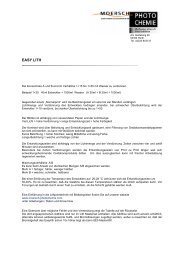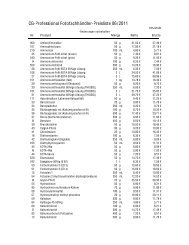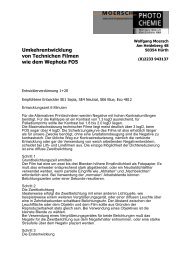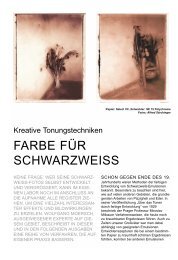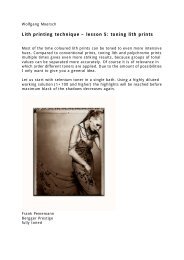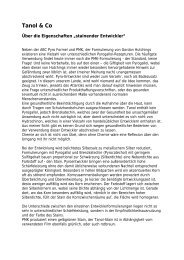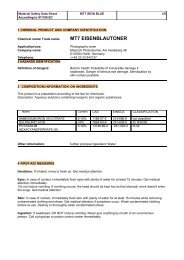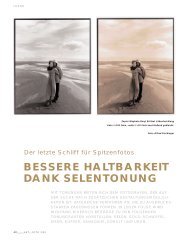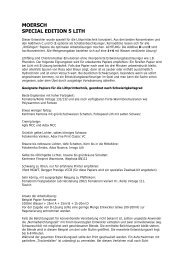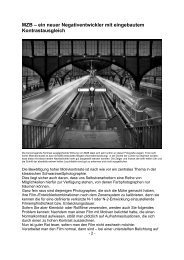COLOR FOR BLACK-AND-WHITE - Moersch-Photochemie
COLOR FOR BLACK-AND-WHITE - Moersch-Photochemie
COLOR FOR BLACK-AND-WHITE - Moersch-Photochemie
Create successful ePaper yourself
Turn your PDF publications into a flip-book with our unique Google optimized e-Paper software.
Creative toning techniques<br />
<strong>COLOR</strong> <strong>FOR</strong><br />
<strong>BLACK</strong>-<strong>AND</strong>-<strong>WHITE</strong><br />
THOSE WHO THINK THAT <strong>BLACK</strong><br />
<strong>AND</strong> <strong>WHITE</strong> ONLY EXISTS OF AN<br />
INFINITE B<strong>AND</strong>WIDTH OF FINE<br />
DIFFERENTIATED GREY TONES<br />
BETWEEN THE TWO EXTREME<br />
ENDS OF THE TONE SCALE WERE<br />
THOUGHT OTHERWISE ON THE<br />
LAST ISSUE. IN THIS SECOND<br />
PART WE ARE TOPPING THAT- IT<br />
GETS EVEN MORE <strong>COLOR</strong>ED.<br />
Paper: Select VC, Developer: SE 15 Polychrome<br />
Photos: Alfred Särchinger<br />
METHODS OF AUTOTONING<br />
development of black-and-white emulsions<br />
were already known toward the end of 19th<br />
century. Attention should particularly be paid<br />
to the basic works, like on many other fields,<br />
of Pizzigheli and Eder. In his publication "about<br />
toning by autotoning development" of 1929 Professor<br />
Miroslav Milbauer from Prague described<br />
procedures which even today still lead to<br />
usable results. Even at times of our grandfathers<br />
one was dependent on suitable emulsions.<br />
Developers leading to wonderful results on a<br />
definite paper, could turn out to be useless on<br />
other emulsions. What the paper choice concerns,<br />
today, we can only dream of the possibilities<br />
of photographers then. Perhaps who
was lucky to have once a paper<br />
example book of Gevaert in hands<br />
for example could have a vague<br />
idea of the black-and-white heaven.<br />
Unfortunately, enlarging papers<br />
without incorporated development<br />
accelerators got rare today. Particularly<br />
the market leaders seem not<br />
to let this nonsense be. That other<br />
ways exist prove manufacturers<br />
from eastern europe like Foma and<br />
Forte as well as the two british companies<br />
Kentmere and Fotospeed, at<br />
least with some of their products.<br />
Since we are just at the topic, I<br />
would suggest the award of a "golden<br />
tomato". Unchallenged first<br />
candidate is the Kodak Company.<br />
Letting the incomparable Ektalure<br />
die is to other quality conscious<br />
photographers and me completely<br />
unaudible. Statements about this<br />
decision must been felt unnecesssary<br />
since, until today, no explanation<br />
concerning this disgrace<br />
was done to me.<br />
The reason why papers with developer<br />
substances or development<br />
accelerators are unfit for toning<br />
developments lies in the super<br />
additive reactions of two or several<br />
developer substances which<br />
increase both the speed and the<br />
diminution capacity of developers.<br />
To produce coloured picture tones<br />
first a high light quantity at simultaneously<br />
delayed picture appearing<br />
is needed by only one developer<br />
substance in low dosage or<br />
low pH value.<br />
The ideal paper for autotoning<br />
development has a high chloro<br />
silver amount. Pure chloro-silver<br />
emulsions are so insensitive that<br />
they would be unsalable today.<br />
Above on the left: Paper Fomatone,<br />
developer metol 1+15 with<br />
ammonium chloride + potassium<br />
carbonate, pH10.10. By<br />
alkaline adding the gradation<br />
was improved but the before<br />
reddish brown tone got green.<br />
Above on the right: Paper<br />
Select Sepia, developer of SE<br />
5 LITH 1+10; The development<br />
was interrupted (after 4 min)<br />
before the "Lith effect" could<br />
occur. The resulting low shade<br />
density is wanted, because it<br />
was completely sufficient for<br />
the further development, in<br />
the second tray of course.<br />
Below on the left: Paper Select<br />
Sepia, developer of SIENNA<br />
glycine+additive) 1:10 pH<br />
9.10. development time 6 min.<br />
Very colorful but weak.<br />
Down on the right: Paper<br />
Select Sepia, first developer<br />
LITH 1:10 4 min stop bath 20<br />
sec, water bath 1 min, second<br />
developer SIENNA 1:10 4 min<br />
Photos: Wolfgang <strong>Moersch</strong>
Paper Classic Arts Polywarmton,<br />
first developer<br />
LITH 1:7 with grain additive<br />
3:30 min, second developer<br />
SIENNA 1:10 5 min<br />
Photo: Rolf H. Funke<br />
Fortunately emulsifiers still<br />
exist which despite all standardizations<br />
and marketing<br />
considerations make their<br />
visions come true and create<br />
high-quality papers for a<br />
circle of smaller becoming,<br />
quality conscious users.<br />
But now back to mentioned<br />
Professor Milbauer. His<br />
recommended prescriptions<br />
(see box for self mixing) are<br />
with some of the available<br />
papers today (see sources<br />
of supply), concerning reddish<br />
brown picture tones,<br />
absolutely usable. With the<br />
increasing red tone however<br />
the gradation course and<br />
shade differentiation get<br />
unsatisfactory.<br />
The effect of all described<br />
prescriptions here is based<br />
on the take up of oxidation<br />
products from the developer<br />
substances onto the silver<br />
grain. Particularly with high<br />
dilutions and small quantities of the oxidation<br />
inhibitor sodium sulphite, colourful picture<br />
tones between yellowish brown and<br />
reddish orange can arise.<br />
Glycine: fine but expensive<br />
The by far most intense colour produces<br />
pyrogallol. At least for positive development<br />
one should keep the hands off this substance.<br />
Pyro is poisonous, thinned working<br />
solutions oxidize so quickly that every print<br />
looks different, in addition, it is rather expensive<br />
for the needed quantities.<br />
Glycin, after tests with various papers is<br />
the ideal substance. Even at very strong<br />
dilutions glycine solutions are extremely<br />
durable and productive. Unfortunately it is<br />
more expensive than pyro. Attention has to<br />
be paid to use glycine which is only fresh or<br />
stabilized with bisulphite. The fresh product<br />
is pale yellow till beige at loose, fluffy<br />
consistency.<br />
Metol produces less intensive tones than<br />
Glycine. It has a reasonable price and in little<br />
quantities available at some photo mailorder<br />
houses. For first attempts one should<br />
concentrate on this substance.<br />
Independent of the used developer substances<br />
a common characteristic of the<br />
prescriptions given here is the addition of<br />
ammonium chloride.<br />
All chlorides delay the development and<br />
cause a moving of the picture tone from<br />
brown into yellowish to reddish nuances.<br />
With high chloride addings the pH value of<br />
the developer descends so much that the<br />
developing capacity strongly reduces. If a<br />
picture is still produced at all, the tone<br />
becomes intense but gradation sinks deeply<br />
up. Now the pH value could be raised<br />
again by alkali addings but especially the<br />
use of highly effective ammonia salts produce<br />
a dichrotic fog and for sensitive<br />
noses the smell of ammonia becomes a<br />
torture. At pH values over 10.0 reddish<br />
tones turn into greenish (see torso next<br />
page on the left).<br />
By renunciation of high chloride quantities<br />
similar intense colors can also be produced<br />
with strong overexposure (4-8 f/stops)<br />
and extreme dilutions. But here too the gradation<br />
becomes extremely unsatisfactory.<br />
The missing shade densities can be increased<br />
with a selenium toning, however,<br />
it needs a little exercise for this approach.
If selenium reacts too long all densities<br />
are increased and the result<br />
is as before -- only "muddy". Now<br />
all done for nothing?<br />
The POLYCHROME TECHNIQUE<br />
Two tray development could save<br />
the whole thing. But the conventional<br />
method must fail here because<br />
at the intense light quantities<br />
needed, a strong second<br />
developer would in any case (at<br />
first or at the second development)<br />
blacken the complete sheet within<br />
seconds. Well, only a developer<br />
working very rich in contrast by<br />
slow picture build up has to be considered.<br />
Only true Lith-developers<br />
fulfill this demand in the ideal way.<br />
For everyone, still not knowing<br />
the Lithprinting method this whole<br />
story will remain unaudible. However,<br />
the understanding of the<br />
chemical coherences is indispensable<br />
for own trials. A short introduction<br />
therefore. Positive developers<br />
usually contain two or three<br />
developing substances, which<br />
together multiply the performance<br />
of a single component. This is<br />
described as Superadditivity.<br />
Developers with only a developing<br />
substance are very slow or<br />
their capacity is low. The hydroquinone<br />
developer takes a special<br />
position if the normally high sulphite<br />
content as oxidation protec-<br />
tion is renounced. This for<br />
every development procedure<br />
inevitable, oxidation<br />
intermediate product, semiquinone,<br />
does not like<br />
other oxidation products<br />
deposit on the already<br />
available metallic silver<br />
but reduces silver salts<br />
and this faster than hydroquinone.<br />
Nothing seems<br />
to be won at first, once<br />
we don't need speed. If<br />
we set in front of these<br />
semi's a chemical barrier,<br />
they need a while to overcome<br />
these. The slower<br />
hydroquinone softly continues<br />
developing in the<br />
meantime. As soon as<br />
sufficient predeveloped<br />
silver germs and sufficient<br />
amounts of semiquinone<br />
exist the barrier is abruptly<br />
Paper Fomatone, first developer of LITH<br />
1:5 3 min, second developer of SIENNA<br />
1:12 4:30 min<br />
The second developer was coordinated<br />
to produce greenish shade tones and<br />
reddish yellow lights. This is reached by<br />
the two enclosed additives. At a following<br />
selenium toning, first the shades<br />
got dense moving the picture at the<br />
same time to a crimson tone. The highlights<br />
at first remain untouched but then<br />
turn slowly to reddish, followed by magenta<br />
tones and lastly get blue. The process<br />
of toning can be interrupted when<br />
the desired picture tone is reached. This<br />
should happen particularly at highly concentrated<br />
toning attempts (1:4 to 1:10)<br />
abruptly. For this the Print has to be<br />
under running water rubbed off on the<br />
front and back side with a cotton ball.<br />
Photos: Uschi Becker
Small picture above:<br />
By addition of ammoniu<br />
chloride and slight increase<br />
of the pH value through carbonate,<br />
shades get green<br />
lying like a fog over the shades.<br />
The more intensive this<br />
tone appears, both density<br />
increase and polychromaticity<br />
will be more distinctive<br />
after a selenium toning.<br />
Small picture below:<br />
Identical with upper picture<br />
before toning. Selenium 1:4<br />
1 min<br />
Large picture on the left:<br />
Before toning shades turn<br />
green at roughly the same<br />
densities. Selenium 1:4 1 min<br />
Photos: Uschi Becker<br />
skipped. The result is a rapid<br />
increasing blackness of highest<br />
opacity starting on the deepest<br />
shade always willing, if we would<br />
allow, to spread out over the<br />
middle tones. Of course we don't<br />
do this and we end the action as<br />
soon as it has enough progressed<br />
for our purposes. For this reason<br />
the print must be put quickly into<br />
the stop bath without long dripping.<br />
Before putting the print into<br />
the second developer it needs a<br />
short but intensive washing. The<br />
reduction of soaked up developing<br />
substances in the paper is<br />
more important than the elimination<br />
of the acid. Interrupter baths<br />
stop the development by neutralizing<br />
the alkalines. The developer<br />
substance remains unimpressed<br />
and would be activated, even if for<br />
a short time, by the alkaline of the<br />
second developer and result in<br />
fog formation. A one minute rinsing<br />
off in the shell with running<br />
water is completely sufficient, at<br />
rocking motion and once water<br />
change.<br />
The picture shades are either fully<br />
developed or vaguely available,<br />
middle tones should be weakly<br />
visible by darkroom light. An altogether<br />
bright picture would just be<br />
right. (See example torso on page<br />
2 above on the right)<br />
The second developer depending<br />
on the developing substance and<br />
coordination, produces more or<br />
less colorful lights and middle<br />
tones. If no or just a very weak<br />
toning is planned, the gradation<br />
must be correct now. If a further<br />
toning for example selenium be
equired, average tones and shades may not<br />
show any high covering, otherwise the print would<br />
get much too heavy after the toning. Still subtly<br />
differentiated shades would run in. The "right"<br />
densities and partial contrasts have to be determined<br />
by own trials. (see nude beside the door)<br />
Per Aspera Ad Astra or Nothing will come<br />
of nothing<br />
Everything described here seems at first sight to<br />
be rather complicated and expensive appea-rances<br />
here are unfortunately NOT deceptive! It is<br />
consuming and for users without experience in<br />
the Lithprinting technique even highly complicated.<br />
Feelings of success will nevertheless<br />
happen quickly. Negatives seeming to be "unprintable"<br />
till now will by using the amazing possibilities<br />
of contrast mastering be able to be copied<br />
onto the paper.<br />
In the next issue further papers and multiple<br />
tonings will be introduced.<br />
Wolfgang <strong>Moersch</strong><br />
(Paper Select Sepia, first developer 6 min LITH coordinated<br />
sharp (with surplus of A solution) but strongly slowed<br />
down with much potassium bromide): A 100 ml: B 70 ml:<br />
Water 700 ml: D (KBr 10%) 40 ml. Second developer 6 min,<br />
SIENNA 1:5<br />
Photo: Uschi Becker<br />
Developer recipes for self mixing:<br />
Pyrogallol developer Set of ready to use developers:<br />
Water 500ml<br />
Sodium sulphite 15 g Developer Set<br />
Sodium carbonat 12 g <strong>Moersch</strong> SPECIAL EDITION 15<br />
Pyrogallol 6 g POLYCHROME<br />
Ammonium chloride 50 g Contains: SE 5 LITH, SE 14 SIENNA and<br />
Potassium bromide 1-2 g additives for picture tone control<br />
Dilution 1:1 to 1:20<br />
Metol developer Recommended papers:<br />
Water 500ml<br />
Metol 10 g Fomatone<br />
Sodium sulphite 25 g Select Sepia, Select Shedlight<br />
Ammonium chloride 25 g Classic Arts Polywarmton<br />
Potassium bromide 2,5 g BerggerPrestige CB Variable<br />
Dilution 1:1 bis 1:10 Forte Polywarmton<br />
Glycine developer Distributors:<br />
Water 500ml Monochrom, Tel.: 0049 (0)561 935190<br />
Sodium sulphite 1,5 g Fotoimpex, Tel.: 0049 (0)30 28599083<br />
Potassium carbonat 3 g <strong>Moersch</strong> <strong>Photochemie</strong><br />
Glycine 1 g Tel.: 0049 (0)2233 943137<br />
Ammonium chloride 5 g Brenner Foto Versand<br />
Potassium bromide 0,25-0,5 g Tel.: 0049 (0)961 6706070<br />
Dilution 1:5 bis 1:50 Lotus View Camera, Tel.: 0043-0-6278-7900



